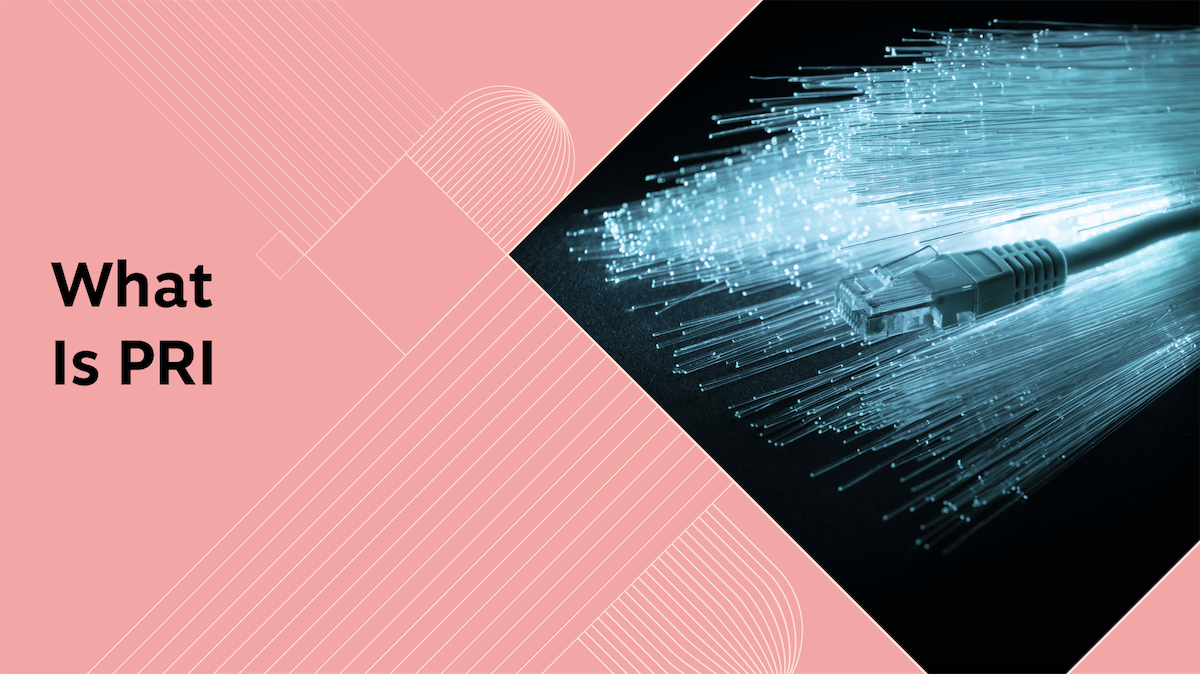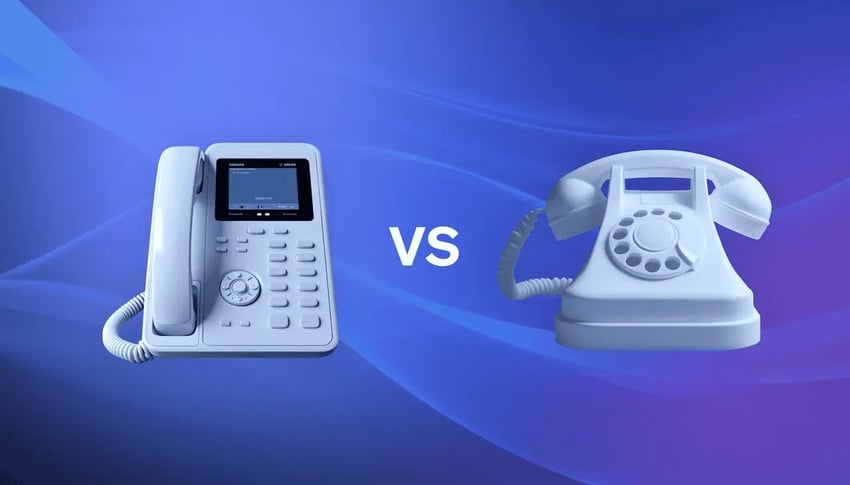Remember those clunky old PBX phone systems that businesses used to rely on? The ones that looked like they were built in the late 1960s and sounded like it? Connecting those relics to the analog phone network was no easy task.
The solution back in the day was an interface called PRI, which is short for Primary Rate Interface. PRI allowed companies to transmit up to 23 calls simultaneously over a single T1 line.
This was a big step up from previous options that required separate lines for each call.
For a period of time, PRI was the definitive way for businesses to set up their phone systems — often called trunks, for years.
Then, Voice over Internet Protocol (VoIP) changed everything.
While PRI is now considered legacy technology, it still has some niche use cases for companies running vintage equipment. In this post, we’ll dive into the history of PRI, how it works, and why VoIP made it obsolete for most modern business phone systems.
We’ll also cover VoIP and other alternatives later in the article.
What Is PRI?
PRI stands for Primary Rate Interface. It’s a type of digital telephone line that connects business telephone systems to the public switched telephone network (PSTN).
PRI carries multiple voice and data transmissions between two physical locations. It uses the Integrated Services Digital Network (ISDN) protocol to provide digital connectivity rather than analog landlines.
Business phone systems that need to support high volumes of concurrent calls and reliable voice/data services, like call centers, offices, hotels, and hospitals primarily use PRI.
With a PRI, businesses benefit from increased call capacity, fast data transmission, integrated voice or data, and lower cost compared to multiple analog lines.
Features of a PRI Line
To better understand how a PRI actually works, let’s first look at some of its key features:
- A PRI line is made up of two pairs of copper wires connecting the service provider (network) to the customer (business end-user).
- PRI is technically one line, but it can simultaneously transmit 23 separate communications (voice, data, or video.) This means up to 23 people in your company can be on the phone (or sending an IM or having a video chat) simultaneously.
- Each of a PRI’s channels has a 64 kbps capacity for data transmissions.
- PRI lines can work with an analog or mixed EPABX setup as well as an IP PBX system.
- A PRI can join two private branch exchange (PBX) systems together, increasing the number of available communication channels.
How PRI Works
The PRI circuit — the actual cable that physically connects your telecom system — is available in two flavors: T1 and E1.
The main difference between the two PRI circuits has a lot to do with geographical location, though there are some technological differences to be aware of:
| E1 | T1 |
|---|---|
| Used in Europe and Australia | Used in North America and Asia |
| Provides 64 Kpbs for data transmission | Provides 64 Kpbs for data transmission |
| Transmit and receive a rate of 2.048 Mbps | Transmit and receive rate of 1.544 Mbps |
| Physically contains two pairs of copper wires | Physically contains two pairs of copper wires |
| 32 total channels | 24 total channels |
| 30 channels used for voice, data, video | 23 channels used for voice, data, video |
| 2 channels are used for signaling | 1 channel used for signaling |
PRI allows for direct inward dialing (DID), meaning someone from outside the company can dial an employee’s direct number and reach them directly. A company can have many individual direct phone numbers for employees, while only needing a limited number of physical phone circuits.

For example, a single PRI circuit with 23 available channels could potentially support up to 50 employees with direct numbers. This works because it’s unlikely all employees will be on calls at the same time.
As a company grows, additional PRI circuits can be added to expand capacity.
So if the initial PRI circuit is fully utilized with 23 simultaneous calls, a second PRI can be added to double the capacity to 46 calls. This modular expandability makes PRI scalable and cost-effective compared to legacy analog phone systems.
PRI provides an efficient and flexible digital telephone solution for businesses.
The shared channels enable many employees to direct numbers while minimizing the physical circuits required. Capacity can be easily expanded as needed by adding supplemental PRI circuits.
Benefits of PRI
PRI offers substantial benefits. Let’s look at some reasons why many businesses still use this tech.
- Cost Savings – Many employees share a small number of physical circuits, reducing costs compared to analog phone lines. Fewer physical lines mean lower monthly charges.
- Scalability – Adding PRI circuits is an easy way to expand capacity as a business grows.
- Call Quality – PRI provides high-quality digital voice quality compared to analog phone lines. The all-digital interface eliminates signal degradation.
- Flexibility – Supports not just voice calls, but also data and video. Channels can be dynamically allocated to different media types as needed.
- Productivity – Features like call forwarding, conferencing, caller ID, and more help employees be more productive. PRI supports advanced capabilities not possible on basic analog lines.
- Reliability – Provides excellent reliability and uptime. Redundant circuits can be added to eliminate single points of failure. PRI is less prone to issues like line noise.
- Management – Offers enhanced management capabilities, allowing full control over the telephone system from one centralized point. Adds, moves, and changes are software-defined.
- Future-Proofing – PRI sets a business up with a modern voice infrastructure that can evolve as needs change. It’s a digital solution rather than outdated analog technology.
Drawbacks of PRI Systems
Up until the 1990s, most business phone systems relied on legacy PBX equipment. While functional, these aging PBX systems were clunky, limited, and difficult to connect to the analog telephone network.
This is where the PRI came in.
For years, PRI was the go-to solution for companies needing to connect their antiquated PBX systems to the PSTN.
But, technology marches on. VoIP emerged in the 2000s as a disruptive force in telecommunications, and PRI began to show its age. Why?
- Cost – PRI lines tend to be more expensive than some other telephony options like VoIP. The hardware and installation costs can be high.
- Capacity limits – Each PRI line supports 23 B channels for voice/data and 1 D channel for signaling. So a single PRI limits you to 23 concurrent calls. To scale up, you need multiple PRIs.
- Complexity – PRIs involve more complex hardware and configurations than analog lines. This can make moves, adds, and changes more difficult. It also requires trained technicians to install and maintain.
- Reliability – Since PRIs rely on the service provider’s network, any issues with their network can impact reliability. Problems like line cuts or switch outages can cause service disruptions.
- Limited flexibility – PRIs support only the signaling standards and features offered by the telco provider. So it may not be possible to enable newer IP-based features.
- Legacy technology – PRIs are tied to older time-division multiplexing (TDM) networks. As telcos move toward IP-based networks, support and evolution for PRIs will diminish over time.
- Limited availability – In some geographic areas, telco providers may not offer PRI services. Availability is diminishing as providers shift focus away from TDM.
Alternatives To PRI
There’s no denying primary rate interface technology changed the way businesses could communicate with customers 30+ years ago. But since that time, advances in telecommunications technology have shined a pretty bright light on some of PRI’s shortcomings.
Businesses are looking for alternatives to PRI. There are several options out there, but not every option is a good fit for every business.
Here’s a look at some key PRI alternatives to consider.
1. Analog POTS lines
POTS is Plain Old Telephone Service. It’s the old-school phone line that connected every house and business.
Your grandparents had one. Your parents had one. You might even have POTS at your house. In the residential space, POTS is often referred to as a landline or a PSTN.
POTS provides service through a single analog circuit connecting the service provider and the user.
A POTS supports one communication at a time. This means a single phone call renders the line unavailable for anything else, like a fax or modem internet access.
At one point in history, analog POTS lines were the way people communicated by phone. And it could still work as a solution for a small business today if phone traffic is minimal.
POTS is generally reliable, but the technology has reached its apex. As other communications systems develop, POTS is slowly disappearing from the scene.
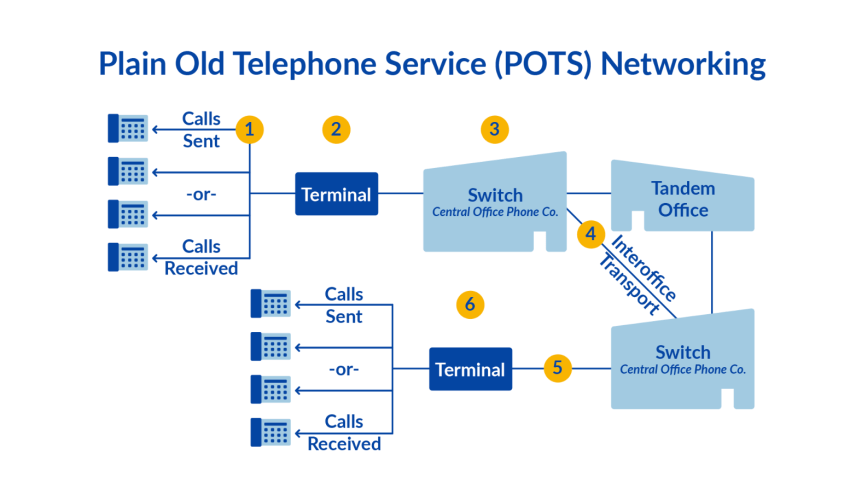
2. SIP trunking
Session Initiation Protocol (SIP) is the method of transmitting voice communication over a data network. A Voice over IP call is an example of a SIP session.
SIP trunking is sort of like a POTS. But, with SIP trunking no phone lines run all over the place. Instead, the ‘lines’ are virtual because the phone system is connected to the service provider through your network (your internet connection).
In the past, SIP trunks have been frequently used as a replacement for POTS or PRI systems. Depending on your business size, it’s still a viable option.

3. Hosted VoIP
Today, businesses of all sizes are moving to a hosted VoIP solution.
A hosted VoIP — also known as a hosted PBX — simply means everything is hosted off-site. The provider hosts the service, deals with the servers and software, and handles maintenance, updates, and troubleshooting.
The service provider manages all of the backend work (whether it be calls, chats, video conferences, etc.) and routes them to the business’s existing phone system.
The big advantage of a host VoIP system over PRI is apparent.
The business itself doesn’t have to worry about expensive equipment, installing and maintaining a big server, or upgrading to the latest software. These things are taken care of by the service provider, saving the business a lot of money, manpower, and headaches.
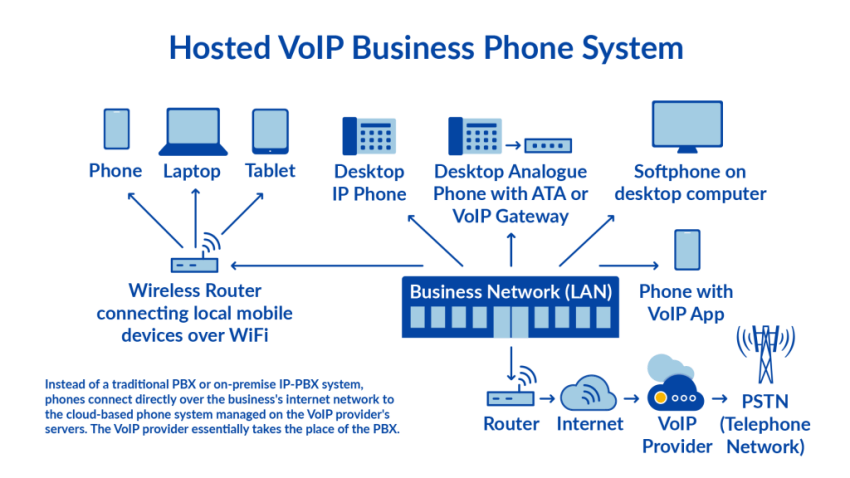
Hosted VoIP vs. PRI vs. SIP Trunking
Let’s take a closer look at the most popular telecommunications solutions on the market today: VoIP, PRI, and SIP trunking. How do the three stack up?
| Feature | PRI | SIP Trunking | Hosted VoIP |
|---|---|---|---|
| Functionality | Traditional digital phone lines to carrier’s PSTN | Uses SIP protocol for voice calls over internet | Cloud-based phone system hosted offsite by a provider |
| Number of simultaneous calls | Up to 23 | Variable | Variable |
| Scalability | Limited | Scalable | Scalable |
| Flexibility | Limited | Flexible | Flexible |
| Cost | Typically more expensive than SIP trunking or hosted VoIP | Uses SIP protocol for voice calls over the internet | Can be less expensive than PRI, but may vary depending on usage |
| Equipment & maintenance | Requires on-site legacy PBX system and hardware and maintenance | Can reduce PRI/PSTN line costs by sending calls over the internet | No on-site equipment required. Hardware is minimal, just IP phones needed |
💰Startup costs
It’s doubtful you’ll find any phone system that doesn’t require some sort of upfront investment. The amount of this investment varies widely depending on the system you choose.
The cost of PRI, SIP trunking, and hosted VoIP varies based on the number of lines needed, the amount of usage, and the features required. SIP trunking and hosted VoIP are typically less expensive than PRI.
- Hosted VoIP – Low startup costs. You’ll need VoIP phones, routers, and high-speed internet. Servers and software are handled by the provider.
- SIP trunking – High startup costs. Requires purchasing and installing an on-site SIP server and separate internet connection. The server and ongoing maintenance are expensive.
- PRI – Medium to high startup costs. Requires installation of physical circuits and a primary rate interface card if using an IP PBX. More circuits mean higher costs.
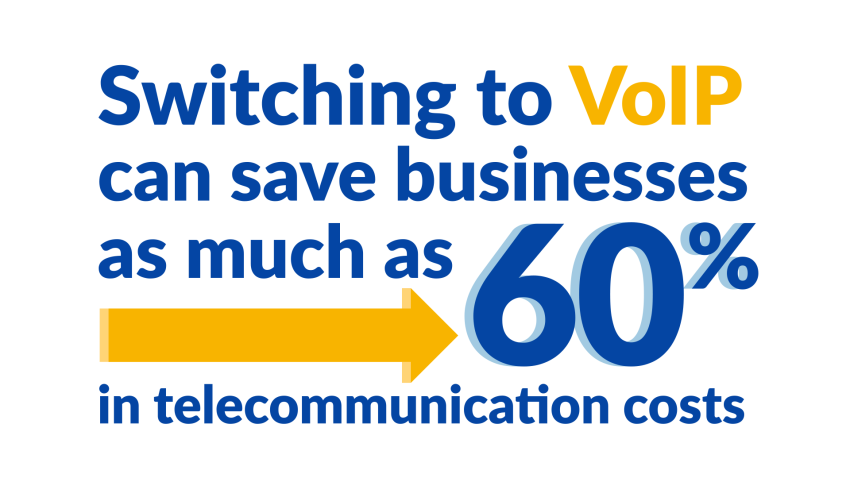
💸 Ongoing costs
The upfront investment isn’t the only cost associated with a phone system. Ongoing costs, whether monthly service fees or maintenance, can quickly impact your ROI.
- Hosted VoIP – Low to medium ongoing costs. Monthly fees are based on users, features, or per-minute rates. Provides more features for a higher fee.
- SIP trunking – Medium to high ongoing costs. Charged per communication channel plus any maintenance. On-premise hardware increases costs over time.
- PRI – Medium to high ongoing costs. Monthly circuit fees plus long-distance and international calling expenses. Maintenance is also expensive.
🔌 Connectivity
Different telecommunications solutions require different kinds of hardware and software. Each system’s connection differs.
- Hosted VoIP – Virtual connection over the internet. No cables are managed on-site.
- SIP trunking – Also virtually connects over the internet, eliminating the need for analog phone lines.
- PRI – Physical circuits installed on-site. More circuits are required for over 23 channels.
🎛 Backup and redundancy
Think of backup and redundancy as ‘what happens in a disaster’. Whether it’s something simple like a power outage or something catastrophic like a tornado, businesses require a system that can support their needs during a disaster.
- Hosted VoIP – Strong backup capability due to its virtual nature and since VoIP providers have redundant hosting sites, easily redirecting calls anywhere in the world.
- SIP trunking – Also has strong backup capability and can point to different locations if connectivity is lost.
- PRI – Weak backup capability. Physical hardware is quite vulnerable but you can add extra circuits for redundancy.
VoIP service providers also plan for disasters or downtime by setting up multiple host sites. If one site is down, service and hosting can easily be rolled to another site.
📊 Business continuity
Business doesn’t stop just because the power goes out or you’re in the middle of a snowstorm.
- Hosted VoIP offers very high continuity and communications can be easily transferred anywhere.
- SIP trunking offers medium continuity and can transfer calls to predefined locations.
- PRI offers the lowest or no continuity and cannot reroute calls if hardware is impacted.
📈 Flexibility and upscaling
Planning for the future growth of a company is imperative when selecting a phone system. The solution should not only fit the business’s current needs but also its forecasted goals and future needs.
The ability to scale a phone system quickly and easily is important.
- Hosted VoIP is highly flexible and quick and easy to deploy. You can easily add more users and features.
- SIP trunking also offers high flexibility. It’s easy to add more trunks to scale up.
- PRI offers the lowest flexibility. Scaling requires installing more circuits, limited to channels in multiples of 23.
☎️ Call quality
The cheapest, most flexible phone system doesn’t matter if the quality of phone calls is terrible. Because of the differences in technology, call quality and service can vary a great deal among the various phone solutions.
- Hosted VoIP offers high call quality but you also need a good internet connection. You may experience network jitter and delays if your bandwidth is low.
- SIP trunking also offers high call quality with a good internet connection. You’ll experience similar issues as hosted VoIP if bandwidth is low.
- PRI offers the lowest call quality compared to VoIP/SIP. You hear more muffled and distant sounds because of the limited frequency range.
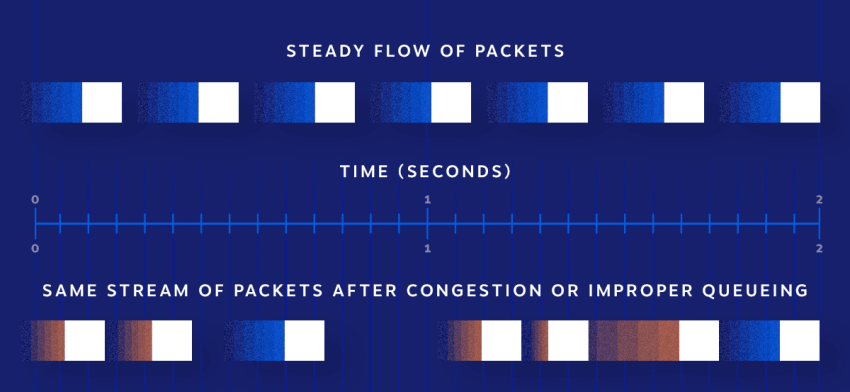
How To Choose the Right Business Phone System
PRI makes the most sense for businesses with a large volume of concurrent voice calls that need dedicated, reliable connectivity to the PSTN. However, PRI is becoming less relevant in today’s internet-driven communication environment.
As carriers transition the PSTN to all IP networks, legacy PRI may eventually be discontinued. Many businesses are switching to VoIP phone systems that don’t require PRI. VoIP calls use broadband internet, which is cheaper and more flexible.
A SIP trunk also has advantages over PRI, especially for the ease of scalability and call quality. Installing a SIP trunk is pretty easy (depending on your current PBX), and your business won’t be burdened with a ton of phone wires.
Though there’s a hefty upfront cost, SIP trunking might be a good option for some businesses to consider.
Better still is the hosted VoIP system. Cost, ease of deployment, scalability, and disaster recovery are all excellent with this solution. It’s simple to manage — getting started is simple, and ongoing management is a breeze.
You don’t need to be an IT professional to set up new users or make changes. Everything is usually done through a simple online dashboard.

Make sure to compare the features, capabilities, and costs of PRI, SIP trunking, and hosted VoIP solutions to determine which option is the best fit for your specific business needs and environment.
Think about call volume, existing infrastructure, IT capabilities, disaster recovery needs, and initial versus ongoing costs. Selecting the right business phone system is a key technology decision that should align with your overall communication strategy and budget.
Simplify Your Communication Infrastructure
A leader in cloud phone systems, Nextiva offers one of the most advanced business communication platforms. Our suite of products can take your company’s connectivity to the next level.
Nextiva’s VoIP phone system connects employees and customers from anywhere. With our ultra-reliable phone service, you’ll never miss an important customer communication.
If you prefer SIP trunking, Nextiva has you covered there too. Our all-inclusive SIP trunking pricing means no surprises or per-minute charges. You get exceptional service at a transparent cost.
Experience the difference world-class business communication can make. Reach out to learn more about Nextiva’s products. Even if you’re not sure what you need, contact us! Our experts would love to discuss your business needs and how Nextiva can help.
Scale up with a VoIP phone system
See how Nextiva helps you deliver the best customer communication.

















 VoIP
VoIP 

